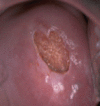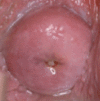Prevalence of precancerous cervical lesions in women attending Mezam Polyclinic Bamenda, Cameroon
- PMID: 31303943
- PMCID: PMC6607283
- DOI: 10.11604/pamj.2019.32.174.16895
Prevalence of precancerous cervical lesions in women attending Mezam Polyclinic Bamenda, Cameroon
Abstract
Introduction: Precancerous cervical lesion is significantly a health problem globally. Thus, screening targeting women between the ages of 17-60 is being undertaken in developing countries, including Cameroon. Over 50% (7.8 per 100,000) women die of cervical cancer every year. This study was to determine the prevalence of precancerous cervical lesion, the age demography and access the risk factor.
Methods: A hospital-based cross-sectional study was conducted from August 09th to October 17th 2017. A total of 60 women participated, and were screened for precancerous cervical lesion. Data were collected by using a questionnaire. Visual inspection with acetic acid and visual inspection with Lugol's iodine was applied for the screening. SPSS version 16.0 was used for data entry and analysis. Logistic regression analysis was fitted and odds ratios with 95% confidence intervals and p-values were computed to identify factors associated with precancerous cervical cancer lesion.
Results: Out of 60 study participants, 2(3.33%) were found to be positive for precancerous cervical cancer lesion.
Conclusion: The prevalence of precancerous cervical lesion in women that consulted at the Mezam polyclinic is high.
Keywords: Mezam polyclinic; Precancerous lesion; age; cervix; screening.
Conflict of interest statement
The authors declare no competing interests.
Figures







Similar articles
-
Factors associated with cervical precancerous lesions among women screened for cervical cancer in Addis Ababa, Ethiopia: A case control study.PLoS One. 2018 Jan 19;13(1):e0191506. doi: 10.1371/journal.pone.0191506. eCollection 2018. PLoS One. 2018. PMID: 29352278 Free PMC article.
-
The prevalence of precancerous cervical cancer lesion among HIV-infected women in southern Ethiopia: a cross-sectional study.PLoS One. 2013 Dec 20;8(12):e84519. doi: 10.1371/journal.pone.0084519. eCollection 2013. PLoS One. 2013. PMID: 24376818 Free PMC article.
-
Precancerous lesions of cervix among women infected with HIV in Referral Hospitals of Amhara Region, Northwest Ethiopia: a cross sectional study.Afr Health Sci. 2019 Mar;19(1):1695-1704. doi: 10.4314/ahs.v19i1.46. Afr Health Sci. 2019. PMID: 31149000 Free PMC article.
-
Precancerous Cervical Lesion Among HIV-Positive Women in Sub-Saharan Africa: A Systematic Review and Meta-Analysis.Cancer Control. 2019 Jan-Dec;26(1):1073274819845872. doi: 10.1177/1073274819845872. Cancer Control. 2019. PMID: 31043067 Free PMC article.
-
Diagnosing Premalignant Lesions of Uterine Cervix in A ResourceConstraint Setting: A Narrative Review.West Afr J Med. 2019 Jan-Apr;36(1):48-53. West Afr J Med. 2019. PMID: 30924116 Review.
Cited by
-
Epidemiology of pre-cancerous cervical lesion and risk factors among adult women in Tigray, Ethiopia.PLoS One. 2023 Jan 6;18(1):e0280191. doi: 10.1371/journal.pone.0280191. eCollection 2023. PLoS One. 2023. PMID: 36608041 Free PMC article.
-
Prevalence of Abnormal Cervical Lesions and Associated Factors Among Women in Harar, Eastern Ethiopia.Cancer Manag Res. 2020 Dec 3;12:12429-12437. doi: 10.2147/CMAR.S279712. eCollection 2020. Cancer Manag Res. 2020. PMID: 33299351 Free PMC article.
-
Cervical Precancer Treatment Outcomes in Cameroon.Int J MCH AIDS. 2024 Sep 13;13:e020. doi: 10.25259/IJMA_8_2024. eCollection 2024. Int J MCH AIDS. 2024. PMID: 39526171 Free PMC article.
-
Prevalence of Precancerous Cervical Lesion and Its Associated Factors Among HIV/AIDS Positive and Negative Women in Debre Berhan Comprehensive Specialized Hospital, North Shewa Zone, Amhara Regional State, Ethiopia: A Cross-Sectional Study.Health Sci Rep. 2025 Aug 19;8(8):e71178. doi: 10.1002/hsr2.71178. eCollection 2025 Aug. Health Sci Rep. 2025. PMID: 40843388 Free PMC article.
-
Association between HIV Serostatus and premalignant cervical lesions among women attending a cervical cancer screening clinic at a tertiary care facility in southwestern Uganda: a comparative cross-sectional study.BMC Womens Health. 2024 Apr 27;24(1):266. doi: 10.1186/s12905-024-03108-w. BMC Womens Health. 2024. PMID: 38678278 Free PMC article.
References
-
- Ackerson K. Interactive model of client health behavior and cervical cancer screening of African-American women. Public Health Nurs. 2011 May-Jun;28(3):271–80. - PubMed
-
- Nji AN. Perceptions of Cameroonian Women Regarding Cervical Cancer Prevention. 2016.
-
- Ali SF, Ayub S, Manzoor NF, Azim S, Afif M, Akhtar N, Jafery WA, Tahir I, Farid-ul-Hasnian S, Uddin N. Knowledge and awareness about cervical cancer and its prevention amongst interns and nursing staff in Tertiary Care Hospitals in Karachi, Pakistan. PloS one. 2010 Jun 10;5(6):e11059. - PMC - PubMed
